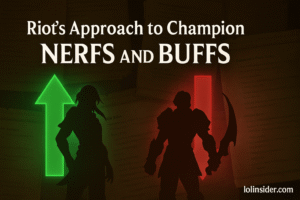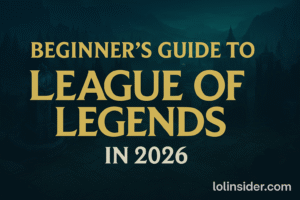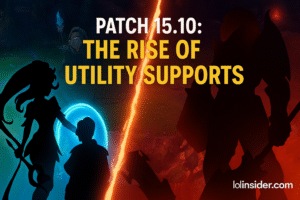Vision wins games. It’s not flashy like a pentakill or a Baron steal, but it’s the foundation of every high-level League of Legends match. Understanding how pro players use vision to win games separates casual players from those who control the map, dictate fights, and suffocate their opponents.
If you’ve ever wondered how pros always seem to know where enemies are, how they make perfect rotations, or how they catch teams off guard, this guide breaks it all down — from ward placement and timing to vision denial and map control.
1. Why Vision Matters More Than You Think
Vision gives information, and information wins decisions.
Every key moment in League — from jungle ganks to objective steals — revolves around vision. When pro teams like T1 or Gen.G dominate, it’s not just their mechanics; it’s how they see the map.
- Vision = Control
- Control = Safety
- Safety = Scaling or Aggression
Without it, even the best mechanics mean nothing.
In professional play, 80% of decisions are based on what teams see — or don’t see — on the map.
2. The Types of Wards and Their Roles
Stealth Ward (Yellow Trinket)
- Default vision tool early game.
- Grants vision for 90–120 seconds.
- Used for early lane control or jungle tracking.
Pro Tip: Replace this with a Control Ward or Sweeper once laning phase ends.
Control Ward (Pink Ward)
- Provides permanent vision until destroyed.
- Reveals and disables enemy wards and traps.
- Used in bushes, river entries, and objectives.
Pro Usage:
Pros often layer control wards near objectives to completely deny enemy vision before key fights.
Oracle Lens (Red Trinket)
- Reveals invisible wards and traps.
- Used aggressively before engages or while invading.
Pro Usage:
Supports and junglers use sweepers before fights to ensure enemies have zero vision advantage.
Farsight Alteration (Blue Trinket)
- Reveals an area instantly from a distance.
- Cannot be cleared (but can be disabled).
- Ideal for scouting Baron/Dragon safely.
Pro Usage:
Carries or top laners use this to scout late-game fog of war when stepping into unwarded jungle is too risky.
3. The Philosophy Behind Vision Control
Pro players view vision not as spots, but as zones of influence.
They divide the map into information sectors, asking:
- Who controls this area?
- Who can safely move through it?
- What can we see vs. what can the enemy see?
Zone Control Example:
- If your team has vision in the enemy jungle’s top side, you can set up picks, invade camps, and secure Herald easily.
- If the enemy controls your jungle vision, you’re forced to play defensive and give up objectives.
Vision isn’t about lighting up the map; it’s about controlling space.
4. Vision Timings: The Pro-Level Rhythm
Pro teams ward and clear vision on a schedule.
Early Game (0–10 min):
- Ward enemy jungle entrances to track early ganks.
- Support + jungler ward enemy raptors or buffs.
- Replace vision after each recall — never leave the map dark.
Mid Game (10–20 min):
- Shift vision toward objectives (Herald, Dragon).
- Supports roam with jungler to secure deep wards.
- ADCs and mids place defensive wards for safety.
Late Game (20+ min):
- Layer vision around Baron and Elder Dragon.
- Use Control Wards in pixel bushes and objective pits.
- Use Blue Trinkets for long-range scouting.
Pro teams synchronize their wards with objective spawn timers — placing them 40–60 seconds before.
5. The Triangles of Vision Control
Pro analysts often describe vision triangles — three-point ward setups that give maximum coverage and safety.
Offensive Triangle (For Attacking Objectives):
- One ward in the river bush.
- One ward in enemy jungle entrance.
- One control ward in objective pit.
Defensive Triangle (For Protecting Territory):
- One ward in lane bush.
- One ward near tower jungle entrance.
- One control ward behind jungle camp wall.
These triangles ensure no blind spots — a concept every pro team uses for rotations and teamfight setups.
6. Vision Denial – The Art of Darkness
Just as vision grants control, denying it creates pressure.
Pro players constantly use sweepers and control wards to turn off the enemy’s map. When your opponent can’t see, they hesitate — and hesitation wins games.
Methods of Vision Denial:
- Pre-objective Sweeps: Before fighting around Dragon or Baron, sweep the area to force blind face-checks.
- Fake Rotations: Clear vision top side but move to Baron — enemy thinks you’re resetting.
- Vision Traps: Leave one ward visible to bait an enemy into clearing it, then engage.
The scariest part of pro play isn’t what’s visible — it’s what’s hidden.
7. Warding by Role – How Each Pro Uses Vision
Top Lane:
- Early: Defensive wards in river or tri-bush.
- Mid: Control wards for TP flanks.
- Late: Use Blue Trinket to scout fog.
Jungle:
- Deep wards in enemy camps to track jungler.
- Uses sweeper for clearing during ganks.
- Controls objective vision zones.
Mid Lane:
- Keeps river wards on both sides.
- Swaps to control wards for side roaming.
- Provides central map vision for rotations.
ADC:
- Defensive wards near lane entrances.
- Uses Blue Trinket late game for scouting flanks.
- Relies on support/jungler for deeper vision.
Support:
- Main vision controller.
- Coordinates all team ward placements.
- Always carries multiple Control Wards.
In pro play, the support and jungler duo control the map’s vision tempo.
8. Vision Before Objectives
Every pro team fight starts with vision setup.
Before Dragon:
- Ward river entrances 1 minute before spawn.
- Place control ward in pit.
- Sweep enemy jungle side.
- Push mid lane to force enemy to face-check.
Before Baron:
- Secure top side jungle vision first.
- Place ward behind pit for flank detection.
- Bait enemies into dark areas.
A fight started with vision advantage has an estimated 70% higher win rate in pro matches.
9. Vision Traps and Bait Plays
Pro players are masters of vision manipulation — setting up traps to punish predictable behavior.
Examples:
- Baron Bait: Clear Baron pit vision, pretend to start, then hide and collapse when the enemy checks.
- Fake Reset: Recall visible, cancel it, and ambush enemies clearing wards.
- One-Side Darkness: Leave one jungle side unwatched to lure enemies into ambush zones.
Vision isn’t just about seeing — it’s about making others think they see safely.
10. Common Amateur Mistakes (and How Pros Avoid Them)
| Mistake | Why It’s Bad | Pro Fix |
|---|---|---|
| Warding randomly | Inefficient coverage | Ward objectives, not bushes |
| Not replacing wards | Lose control midgame | Reset ward timer every recall |
| 3 Control Wards stacked in one area | Waste of gold | Spread vision in layers |
| Ignoring enemy sweepers | Lose info silently | Reward areas after clear |
| Face-checking without vision | Instant death | Use trinkets or poke before entering fog |
Vision isn’t optional. It’s an investment — every ward can change a fight’s outcome.
11. Vision and Macro Play – How Pros Think Ahead
In pro matches, vision drives macro strategy.
- Objective Trades: Teams trade Dragons for Heralds based on vision control zones.
- Rotations: Mid push → ward enemy jungle → invade side lanes.
- Flank Control: Teams preemptively ward behind objectives to stop TP or flank plays.
Every rotation, recall, and engage is calculated through vision data — not guesswork.
12. The “Vision Funnel” Concept
High-level teams think of vision as a funnel of information:
- Broad early vision → Deep mid-game vision → Focused late-game control
This funnel narrows as objectives become more important, concentrating wards around Baron, Elder, or Nexus defenses.
Pro supports plan this 5 minutes ahead — predicting where the next fight will happen and shifting vision accordingly.
13. How Pro Teams Communicate Vision
Vision control is a teamwide system, not individual effort.
- Support: “River pinked, I’ll clear top side next.”
- Jungler: “Their blue side dark, we can invade.”
- ADC: “No vision bot, I’ll play back.”
Pro teams constantly call out:
- Wards spotted
- Sweeper cooldowns
- Objective timers
- “Fog zones” (areas currently dark)
In solo queue, even typing “no vision bot river” can prevent deaths and turn fights.
14. Analyzing Vision Like a Pro
When watching replays, pro players track vision movements as carefully as champion positioning.
In Pro VOD Reviews, Analysts Check:
- Where each ward was placed and cleared
- How long vision lasted
- What plays resulted from that information
Vision wins aren’t luck — they’re tracked, analyzed, and repeated.
15. How to Train Your Vision Control
You can practice like the pros with these simple drills:
- Replay Study: Watch your games and check where your wards actually gave vision.
- Objective Timer Drills: Practice warding 45 seconds before spawn.
- Vision Sweep Runs: Sweep one jungle quadrant every 2 minutes.
- Map Awareness Check: Press tab every 10 seconds to plan where to ward next.
Mastering vision isn’t glamorous — but it’s how you control the map.
16. The Psychological Impact of Vision
A team with vision feels confident. A team without it plays scared.
Pro teams exploit this fear:
- They zone enemies from objectives using darkness.
- They force mistakes from anxious teams checking blindly.
Vision doesn’t just give map control — it gives mental control.
17. How Vision Wins Championships
Think of every major final — from T1 at Worlds to JDG’s map domination.
The teams that win don’t just fight better — they see better.
- Perfect Baron traps
- Objective steals with full vision denial
- Early game invades tracked by deep wards
Vision translates to control, and control translates to victory.
18. FAQs
Q1: How many wards should I have on the map?
Ideally, your team should maintain 8–10 active wards during mid/late game, including control wards.
Q2: When should I switch from yellow to red trinket?
Around level 9 or after your first support item upgrade — whenever you begin roaming or contesting objectives.
Q3: What’s the best vision setup for Baron?
Two control wards (pit + pixel bush) and three stealth wards (river entrance, enemy jungle, flank bush).
19. Conclusion
Understanding how pro players use vision to win games is the single most underrated skill in League of Legends.
Mechanics win fights — but vision wins wars.
It dictates movement, timing, objectives, and confidence.
Start treating wards not as “extra items,” but as your sixth teammate.
Learn to light the map, deny your enemies, and you’ll find yourself winning more games before the fights even start.







